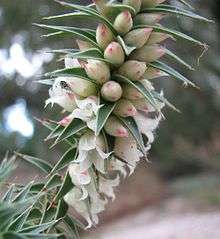Melichrus urceolatus
| Melichrus urceolatus | |
|---|---|
 | |
| Melichrus urceolatus | |
| Scientific classification | |
| Kingdom: | Plantae |
| (unranked): | Angiosperms |
| (unranked): | Eudicots |
| (unranked): | Asterids |
| Order: | Ericales |
| Family: | Ericaceae |
| Genus: | Melichrus |
| Species: | M. urceolatus |
| Binomial name | |
| Melichrus urceolatus R.Br. | |
| Synonyms | |
|
Styphelia urceolata (R.Br.) F.Muell. | |
Melichrus urceolatus, commonly known as urn heath or honey-gland heath, is a species of flowering plants in the family Ericaceae. The species is native to Queensland, New South Wales and Victoria in Australia.[1] It is an erect shrub that grows to between 0.2 and 1.5 metres in height. The white, cream or yellow-green flowers, are clustered toward the branch bases and appear between March and November in the species native range.[1]
The species was first formally described by botanist Robert Brown in 1810 in Prodromus Florae Novae Hollandiae.[2]
Associated tree species in Victoria include Eucalyptus macrorhyncha, E. microcarpa and E.polyanthemos.[3]
References
- 1 2 "Melichrus urceolatus". PlantNET - New South Wales Flora Online. Royal Botanic Gardens & Domain Trust, Sydney Australia. Retrieved 2010-06-06.
- ↑ "Melichrus urceolatus". Australian Plant Name Index (APNI), IBIS database. Centre for Plant Biodiversity Research, Australian Government, Canberra. Retrieved 2010-06-06.
- ↑ Wild Plants of Victoria (database). Viridans Biological Databases & Department of Sustainability and Environment. 2009.
This article is issued from Wikipedia - version of the 5/1/2016. The text is available under the Creative Commons Attribution/Share Alike but additional terms may apply for the media files.